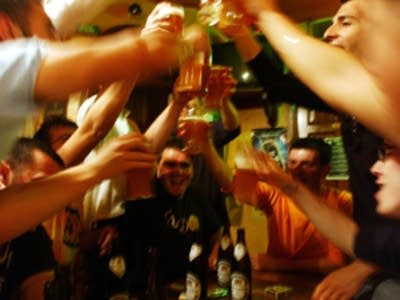Binge drinking is not so new
Go Deeper.
Create an account or log in to save stories.
Like this?
Thanks for liking this story! We have added it to a list of your favorite stories.

Parents worry about it. Professors complain about it. Students tend to shrug it off. It's a plain reality.
"College students have always drunk a lot of alcohol."
Researchers, including Lloyd Johnston at the University of Michigan's Institute for Social Research, spend a lot of time trying to get a handle on it.

Johnston has been tracking students from high school, into college and beyond, for 27 years.
Turn Up Your Support
MPR News helps you turn down the noise and build shared understanding. Turn up your support for this public resource and keep trusted journalism accessible to all.
He says among high school students, college students, and young people who aren't in college, it's the college students who do the most binge drinking.
"That's been a consistency, and it's not terribly different today than it was 20 years ago," says Johnston.
Forty percent of college students say at least once in the two weeks before they fill out Johnston's survey, they've had five or more drinks in a row. By definition, that's binge drinking.
Johnston says these binge drinkers usually attend to their studies during the week, and on weekends, they drink a lot.
That's familiar to Aruna Rao. She graduated from the University of Minnesota last May, and now she works for a biomedical company in the Twin Cities.

"If you're in school, there's a lot of pressure to do well. And in order to have some fun, people let themselves loose by drinking," says Rao.
And she says they're finding plenty of occasions to let loose.
"For example, once finals are over, it's a huge trend to party," says Rao. "And right before classes begin for a semester, people have one last bash, or even before a stream of tests."
Their teachers are seeing the results in class. Some students regularly engage in heavy drinking.
"It's not a mystery when a student comes to class showing that illness, and that misery from a round of binge drinking," says a college professor who teaches in Minnesota.
"Once finals are over, it's a huge trend to party. And right before classes begin for a semester, people have one last bash, or even before a stream of tests."
She asked us not to use her name because she doesn't want to draw criticism to her college. But she says today's behavior reminds her very much of the way it was when she was a student, 20 years ago.
"Big parties, small parties almost every night of the week, and the purpose was to drink as much as possible," she says. "I don't know if students today are using grain alcohol the way that it was being used in the '80s, but this really vicious drink, that would pretty much move one to blackout immediately."
This professor drank all the way through college, and it wasn't until she was working that she realized she had a problem. She's now an active member of Alchoholics Anonymous.
In the emergency department at Hennepin County Medical Center, a special section is set aside just for alcohol patients.
In 2006, the last year for which we have full figures, there were 3,278 visits to emergency rooms in Minnesota related to alcohol among adults. There were 636 trips to the ER that involved underage drinking. That's more than two a day, each day, for the entire year.
Dr. Joseph Clinton directs HCMC's emergency department. He says on Friday and Saturday nights, all the beds for alcohol patients are full.
"One typical situation would be someone who is in a bar drinking shots on their 21st birthday, and for some reason there's this idea that they need to drink 21 drinks or 21 shots," says Clinton. " And the people who are doing it, drinking these shots, just don't understand how bad it can be."
Too much alcohol poisons the body, and sometimes people die. The lucky ones get to the emergency room in time.
"We've had a number of cases, people that if they were not attended to, would very likely have died, because they'd stopped breathing or they had aspirated stomach contents or had seizure activity," Clinton says.
There are no guidelines on how much alcohol is safe. The most common reason for visits to the emergency room is for injuries that probably wouldn't have happened without the influence of alcohol -- falls, car crashes, broken bones, concussions.
Dr. Clinton says he expects to be treating young people for alcohol-related problems for the rest of his career.
Young people tend to engage in risky behavior of all kinds. They have a feeling of invincibility, that tells them they can do practically anything and survive.
But according to a 2005 estimate, college drinking contributes to 1,700 deaths each year across the country.
Such figures are a warning sign, according to Carol Falkowski, director of Chemical Health at the Minnesota Department of Human Services.
"Whenever anyone dies unintentionally from drinking too much, that is a preventable death," says Falkowski. "I think we need to do a better job of working with college students, to educate them to the basic fact that simply drinking too much alcohol can kill you."



